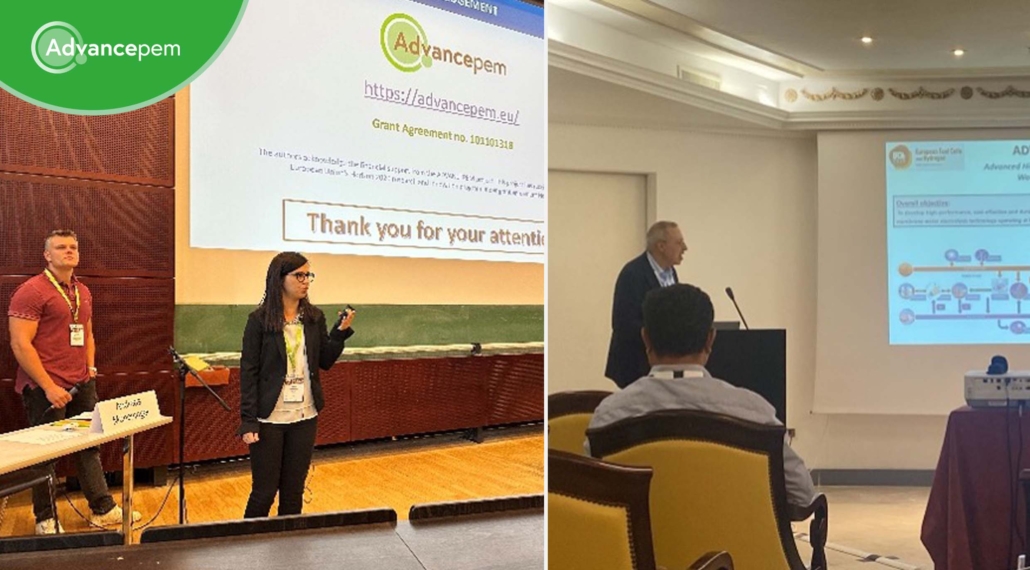ICE25 & EFCH225 – CNR-ITAE

Researchers from CNR-ITAE recently presented new findings on short-side chain Aquivion® membranes at two major European conferences.
Fausta Giacobello, researcher at CNR-ITAE, attended the 5th International Conference on Electrolysis in Freiburg, Germany. Her presentation focused on key results from a detailed assessment of the performance and durability of Aquivion® membranes, aimed at improving PEM electrolysis.
Antonino S. Aricò, Director of CNR-ITAE, shared the latest developments on high-performance, thin short-side chain Aquivion® membranes at the European Fuel Cell and Hydrogen Piero Lunghi Conference in Capri, Italy.
These findings represent a significant step toward more efficient and cost-effective high-pressure PEM water electrolysis, supporting the advancement of green hydrogen production.
Below are the abstracts from both presentations.
Abstract – Aquivion® membranes with low equivalent weight for improved PEM water electrolysis
To achieve sustainable growth and mitigate the effects of climate changes, the transition from fossil fuels to cleaner energy sources is becoming important. The development of new energy vectors and their integration with renewable energy sources and the energy grid infrastructure, however, present challenging barriers. It is often acknowledged that creating more scalable and effective storage solutions is essential to a sustainable future.[1] Green hydrogen, generated via electrolysis, offers significant advantages: high energy density, improved transport efficiency and diverse applications spanning energy conversion and numerous industrial processes. PEM (proton exchange membrane) electrolysis is a particularly advantageous technology for water splitting, achieving high current densities, superior efficiency, high-purity hydrogen production and rapid response. [2-3] This study investigates the performance and durability of different Aquivion® short side chain membranes for PEM electrolysis, a crucial area for developing highly efficient and stable electrolyzers. The research compares bare cast polymers, radical scavenger-containing polymers, and reinforced films, evaluating their performance in MEAs (membrane-electrode assemblies) by means of polarization tests, EIS (electrochemical impedance spectroscopy), and long-term (2000 hour) durability tests. Further analysis using XRD, XRF, TEM, SEM, and optical microscopy clarify membrane and ionomer dispersion characteristics within the MEAs and their impact on overall performance and durability. Using both reinforced and radical scavenger-based membranes, an outstanding electrolysis performance was obtained at 90°C with 1.87 V at 5 A cm-2 . The voltage efficiency at 5 A cm-2 is around 79%. To decrease the final cost of green hydrogen and the amount of renewable energy used, high voltage efficiencies are required. High operational current densities, on the other hand, are basically associated with lower capital costs because of the increased output rate. This is necessary for PEM to minimize utilization of CRMs. Postoperation analyses have shown minimal changes in the catalytic layers and essentially no membrane thinning. All this evidence indicate promising durability perspectives for the modified membranes.
Abstract – High performance of a thin short-side-chain Aquivion® membrane for sustainable water electrolysis application
A perfluorosulfonic acid (PFSA) Aquivion® membrane (C98 05S-RSP) based on Ce-radical scavenger technology was developed and evaluated for use in polymer electrolyte membrane (PEM) electrolyzers. Manufactured by Solvay Specialty Polymers, the membrane had an equivalent weight (EW) of 980 g/eq and a thickness of 50 μm to minimize ohmic losses at high current densities. The electrochemical properties and gas crossover were assessed after creating a membrane-electrode assembly (MEA) over a temperature range of 30 to 90°C and under varying differential pressures (ambient, 10, and 20 bars). For comparison, bare extruded (E98 05S) and reinforced (R98 05S) PFSA Aquivion® membranes with similar EWs and thicknesses were tested under the same conditions to evaluate their performance, stability, and hydrogen crossover. The membrane manufacturing method had a notable impact on the interfacial properties, with the electrodes influencing polarization resistance, H2 permeation in the oxygen stream, and the degradation rate, as indicated by the durability tests.





